Meredith Monk’s new On Behalf of Nature at the BAM Harvey.
“I work in between the cracks, where the voice starts dancing, where the body starts singing, where theater becomes cinema.” Meredith Monk said that in 1981. And although many of us knew her first as a startlingly original downtown 1960s choreographer, she has since composed music that interweaves various modes of performance and ritual—much as some forms of Asian theater do. Her works evade pigeonholing. You could try filing them as dances, solo songs, vocal compositions for a group, orchestral works, operas, films, or site-specific spectacles, but you’d soon find yourself floundering in overlaps and arguments.
As of 2014, Monk has been creating her extraordinary pieces for fifty years. To celebrate this half-century of achievement, Carnegie Hall—whose Richard and Barbara Debs Composer’s Chair she now occupies—has already, this Fall, sponsored two performances that honor her music and its influences, and will present five more in February, March, and May of 2015. The Brooklyn Academy of Music’s Next Wave Festival is offering the premiere of her On Behalf of Nature from December 3 through 7.
Monk is never explicitly political in her compositions, but she has always been an intent observer of how life on this planet is lived, what flourishes, and what is destroyed. She doesn’t point a finger at willful pollution and environmental destruction, but the formal patterns of movement and the musical textures in On Behalf of Nature convey these through harmony and unresolved dissonance, along with an interdependence among people and between us and other species. In a swarm of film clips that is shown at one point, lovers kiss, a flower unfolds in slow motion, tiny creatures seen under a microscope swim around (not all the images are this peaceable). At other times, the projection resembles ocean waves with stylized brownish ripples that make you think of oil slicks. That backdrop can also, thanks to Elaine Bucholtz’s superb lighting, conjure up the bluest, most cloudless of skies.
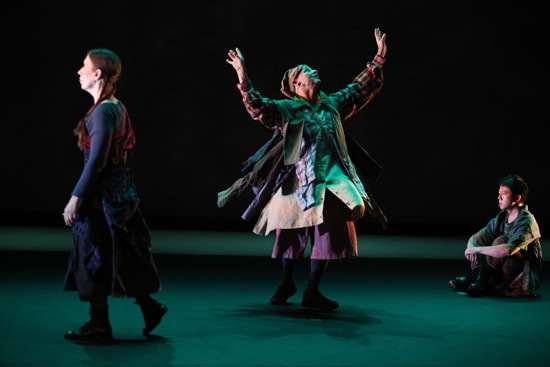
L to R: Meredith Monk, Ellen Fisher, and Sidney Chen in Monk’s On Behalf of Nature. Photo: Julieta Cervantes
Repurposing and recycling become a visual and atmospheric motif in On Behalf of Nature. Monk and her Vocal Ensemble perform—appropriately—in the BAM Harvey Theater. The lobby, with its splotchy paint and crumbling ceiling fixtures, has mostly been left alone since its last days as a movie house decades ago. The theater itself still has bits of color that were there for Peter Brook’s 1987 production of the Mahabharata, which opened the renovated building. For this new work of Monk’s, her longtime collaborator, designer Yoshio Yabara, asked the nine performers to bring in articles of clothing that were meaningful to them. These he cut up and stitched into terrific new costumes (sketches with affixed explanatory post-its hang in the lobby). If you look closely, you can see how a pair of pants has been flattened and appliqued to a skirt, and that the striped swag across one of Monk’s shoulders can be identified as a former beloved tee shirt. The color scheme of the clothes changes over the piece; they start out mostly in blues and greens, grade to to earth tones, and finally become white.
When the audience enters the theater, six gleaming rings the size of bracelets hang from six wires about a foot off the floor of the stage. When they are raised, the light pools beneath them take a moment to disappear. We’ve heard the performers before we see them. At least, if you listen beneath the noises of people entering, taking their seats, and chatting, you can hear distant voices (warming up maybe), and for a few seconds, they sound like a buzzing hive.
There are six superb singer-dancers: Sidney Chen, Ellen Fisher, Katie Geissinger, Monk, Bruce Rameker, and Allison Sniffin. But Bohdan Hilash (winds) and John Hollenbeck (percussion) occasionally come out from behind their instruments to walk or run with the others, and Sniffin moves to a place behind the array of music-making stuff to play keyboards, violin, or French horn. The musicians themselves perform a kind of dance as they move among the pieces of equipment. Now Hollenbeck is playing vibes, now he’s ringing a singular, celestial-sounding brass bell, now he’s pattering sticks on something else. One minute, you hear the growl of Hilash’s bass clarinet; later you may glimpse him with a shrill pipe between his lips. The other six not only sing and move, they snap their fingers and, at one point, rub their arms close to the barely visible microphones they wear.
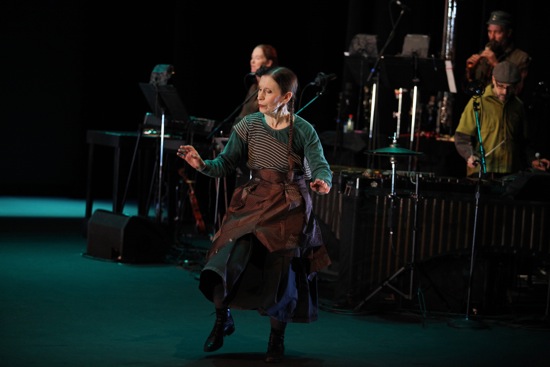
Meredith Monk and at back (L to R): Allison Sniffin, Bohdan Hilash, and John Hollenbeck. Photo: Julieta Cervantes
Monk built her musical identity on her own uncanny voice. Her range is phenomenal—not just in terms of octaves, but in terms of what she allows or incites that voice to do. Pure tones keep company with nasal ones, as well as with shrieks and growls and clicks and whispers. Repetition is key; brief modules may recur many times, both in the vocalizing and in the instrumental texture. But surprising outbursts can erupt from these; at one point Monk delivers a short solo that sounds like an angry harangue, while she slices the air with her arms in all directions. And her command of dynamics is brilliant—often so delicate that that you wonder how four sticks quietly hitting metal keys or a single, soft human voice can seem both intimate and a call to something immense.
When I listen to this beautiful, fastidiously composed music, I find myself thinking at times of a field at night. There may be a continuum of crickets, with fluctuating gusts of wind. Within this, you may hear an owl hoot intermittently, a fox bark, a rustling in the grass, or human footsteps.
Monk rarely uses words in her songs, yet the repeating syllables or bursts of regimented gibberish can seem like stories told or conversations held in the language of a lost race. Her counterpoint suggests individuals contributing to a joint project—one person perhaps only delivering short, intermittent notes, another working out a fragment of melody. The actions that accompany the singing or the instrumental passages reinforce images of a society of individuals who share the same space.
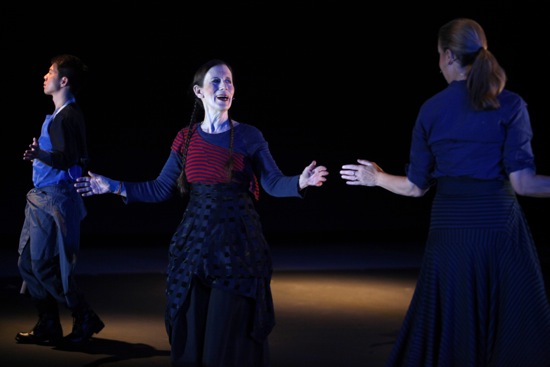
L to R: Sidney Chen, Meredith Monk, and Katie Geissinger in On Behalf of the Planet. Photo: Julieta Cervantes
And if the music itself conveys aspects of terrain, so do the movements of the performers and their focus. Their gaze is often alert, inquiring; it enlivens the space around them. Sometimes you see them busy with what might be a specific task. Watching Chen at one point, I think of a fisherman or a hunter, intent on something low to the ground. Fisher seems to be remembering a folk dance. Geissinger’s brief, onetime only swish of her skirt also evokes a gathering-to-come. The performers’ passages within the frame of the stage hint at different locales and (maybe) populations. If they walk, widely spaced out on horizontal tracks that crisscross the stage, you think of urban settings calmed down or ships that pass in the night. If they run clustered together to one corner or another, you sense something important beyond the area that we can see.
The clarity and apparent simplicity of much that we hear and see shelters complexity. In one lovely scene, Geissinger and Rameker walk onto the stage, gazing as if at a fine and tranquil scene, and sit on the floor side by side. She sings softly, musingly, and he gradually begins to interject tones of his own. They’re like a couple so close that they can finish each other’s sentences. Then he reaches out to pull her up, and, swinging hands, they walk to a new spot and sit again to continue their dialogue. Underneath, we hear a quiet oboe and keyboard notes. Sniffin tickles the strings of her violin. By the time the two progress to a third location—upstage with their backs to the audience—we have realized from the very simple variations in what they do and “say,” that theirs is a progress through time. By the end, they are slower and older; she puts her head on his shoulder. Their duet is ended by a bell, sudden brightening of the lights, quiet percussive rhythms, and a new climate in a work that is, subtly, a poetic collage of images and sounds.
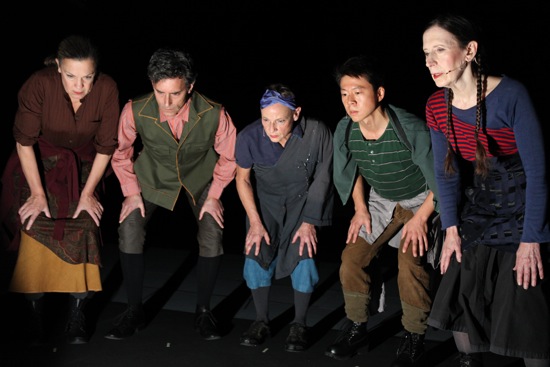
L to R: Katie Geissinger, Bruce Rameker, Ellen Fisher, Sidney Chen, and Meredith Monk. Photo: Julieta Cervantes
We sense weather and seasons in On Behalf of Nature through changes in the light and its temporary absences, and through sounds like thunder or a brief wildness of noisemakers. Gestures also seem to respond to landscape. Once, gathered in a corner, the performers stir the air above them with one stiff arm. In another sequence, when Fisher traces fluid circles with her arms, wrists, and fingers, I think of someone sensing snowfall.
Monk, however, is rarely literal; she evokes rather than describes, and her meanings are elusive. We see two people conversing, but we don’t know (or need to know) exactly what they are telling each other. When, after a seconds-long blackout, five performers rush forward and stop very close to the audience, all bending to stare at the same spot on the floor, we don’t know what they are seeing; we only know that it is of significance to them all equally. At the end of the piece, the rings descend again, and the six vocalists each pull on one and then set it swinging. The image is luminous and distractingly beautiful, hinting at cosmic paths. It may also be understood as tolling bells, and pendulums marking the irrevocable passing of time.
I think Monk is a genius in terms of her art, but also a kind of shaman —wise and innocent and deeply in touch with the natural world on whose behalf she and her greatly gifted colleagues created this marvelous piece.

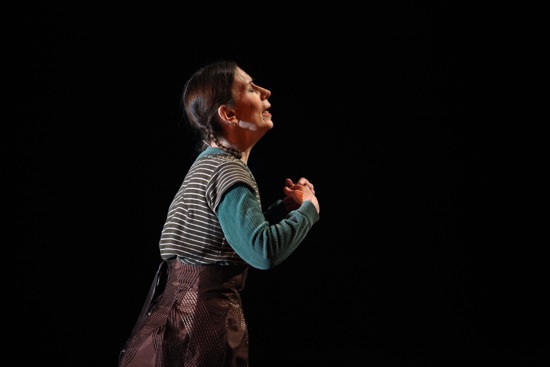
I first saw (and heard) Meredith Monk’s work in 1979 and thought it was a knockout. Needless to say I would have loved to have seen “On Behalf of Nature,” but three thousand miles is a little far to go. This beautifully and insightfully written review is almost as good as being in the theater myself and for that Deborah I thank you very much indeed.
I just wanted to make sure that Martha is aware that there is a West Coast run scheduled for the last weekend of March 2015, in San Francisco at the Yerba Buena Center for the Arts. Their site isn’t live yet but some details can be found here: https://facebook.com/events/317527968449467
Thanks for writing this wonderful article!